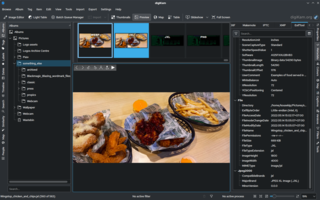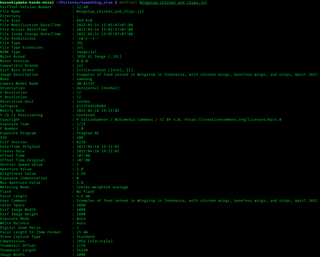Related Research Articles
The JPEG File Interchange Format (JFIF) is an image file format standard published as ITU-T Recommendation T.871 and ISO/IEC 10918-5. It defines supplementary specifications for the container format that contains the image data encoded with the JPEG algorithm. The base specifications for a JPEG container format are defined in Annex B of the JPEG standard, known as JPEG Interchange Format (JIF). JFIF builds over JIF to solve some of JIF's limitations, including unnecessary complexity, component sample registration, resolution, aspect ratio, and color space. Because JFIF is not the original JPG standard, one might expect another mime-type. However, it is still registered as "image/jpeg".
Tag Image File Format, abbreviated TIFF or TIF, is an image file format for storing raster graphics images, popular among graphic artists, the publishing industry, and photographers. TIFF is widely supported by scanning, faxing, word processing, optical character recognition, image manipulation, desktop publishing, and page-layout applications. The format was created by the Aldus Corporation for use in desktop publishing. It published the latest version 6.0 in 1992, subsequently updated with an Adobe Systems copyright after the latter acquired Aldus in 1994. Several Aldus or Adobe technical notes have been published with minor extensions to the format, and several specifications have been based on TIFF 6.0, including TIFF/EP, TIFF/IT, TIFF-F and TIFF-FX.

Exchangeable image file format is a standard that specifies formats for images, sound, and ancillary tags used by digital cameras, scanners and other systems handling image and sound files recorded by digital cameras. The specification uses the following existing encoding formats with the addition of specific metadata tags: JPEG lossy coding for compressed image files, TIFF Rev. 6.0 for uncompressed image files, and RIFF WAV for audio files. It does not support JPEG 2000 or GIF encoded images.
GraphicConverter is computer software that displays and edits raster graphics files. It also converts files between different formats. For example, one can convert a GIF file to a JPEG file.
The International Press Telecommunications Council (IPTC), based in London, United Kingdom, is a consortium of the world's major news agencies, other news providers and news industry vendors and acts as the global standards body of the news media.
Digital Negative (DNG) is a patented, open, lossless raw image format developed by Adobe and used for digital photography. Adobe's license allows use without cost on the condition that the licensee prominently displays text saying it is licensed from Adobe in source and documentation, and that the license may be revoked if the licensee brings any patent action against Adobe or its affiliates related to the reading or writing of files that comply with the DNG Specification. It was launched on September 27, 2004. The launch was accompanied by the first version of the DNG specification, plus various products, including a free-of-charge DNG converter utility. All Adobe photo manipulation software released since the launch supports DNG.
The Extensible Metadata Platform (XMP) is an ISO standard, originally created by Adobe Systems Inc., for the creation, processing and interchange of standardized and custom metadata for digital documents and data sets.
An Image file format is a file format for a digital image. There are many formats that can be used, such as JPEG, PNG, and GIF. Most formats up until 2022 were for storing 2D images, not 3D ones. The data stored in an image file format may be compressed or uncompressed. If the data is compressed, it may be done so using lossy compression or lossless compression. For graphic design applications, vector formats are often used. Some image file formats support transparency.

XnView is an image organizer and general-purpose file manager used for viewing, converting, organizing and editing raster images, as well as general purpose file management. It comes with built-in hex inspection, batch renaming and screen capture tools. It is licensed as freeware for private, educational and non-profit uses. For other uses, it is licensed as commercial software.
A camera raw image file contains unprocessed or minimally processed data from the image sensor of either a digital camera, a motion picture film scanner, or other image scanner. Raw files are named so because they are not yet processed and therefore are not ready to be printed, viewed or edited with a bitmap graphics editor. Normally, the image is processed by a raw converter in a wide-gamut internal color space where precise adjustments can be made before conversion to a viewable file format such as JPEG or PNG for storage, printing, or further manipulation. There are dozens of raw formats in use by different manufacturers of digital image capture equipment.

Windows Photo Gallery is a discontinued image organizer, photo editor and photo sharing program. It is a part of Microsoft's Windows Essentials software suite. The product has been unavailable for download since January 10, 2017, as the Windows Essentials line of products have been discontinued.

An image organizer or image management application is application software for organising digital images. It is a kind of desktop organizer software application.
Windows Imaging Component (WIC) is a COM-based imaging codec framework introduced in Windows Vista for working with and processing digital images and image metadata.

FastPictureViewer is a freemium image viewer for Windows XP and later. Its aim is to facilitate quick review, rating and annotation of large quantities of digital images in the early steps of the digital workflow, with an emphasis on simplicity and speed. As an app with a freemium license, a basic version is available cost-free for personal, non-profit or educational uses, while a commercial license is required for the professional version with additional features. The basic version starts as a full version trial.

ExifTool is a free and open-source software program for reading, writing, and manipulating image, audio, video, and PDF metadata. It is platform independent, available as both a Perl library (Image::ExifTool) and command-line application. ExifTool is commonly incorporated into different types of digital workflows and supports many types of metadata including Exif, IPTC, XMP, JFIF, GeoTIFF, ICC Profile, Photoshop IRB, FlashPix, AFCP and ID3, as well as the manufacturer-specific metadata formats of many digital cameras.
Sidecar files, also known as buddy files or connected files, are computer files that store data which is not supported by the format of a source file.
A file format is a standard way that information is encoded for storage in a computer file. It specifies how bits are used to encode information in a digital storage medium. File formats may be either proprietary or free.

RawTherapee is application software for processing photographs in raw image formats, as created by many digital cameras. It comprises a subset of image editing operations specifically aimed at non-destructive post-production of raw photos and is primarily focused on improving a photographer's workflow by facilitating the handling of large numbers of images. It is notable for the advanced control it gives the user over the demosaicing and developing process. It is cross-platform, with versions for Microsoft Windows, macOS and Linux.

The Metadata Working Group was formed in 2006 by Adobe Systems, Apple, Canon, Microsoft and Nokia. Sony joined later in 2008.

The Extensible Device Metadata (XDM) specification is an open file format for embedding device-related metadata in JPEG and other common image files without breaking compatibility with ordinary image viewers. The metadata types include: depth map, camera pose, point cloud, lens model, image reliability data, and identifying info about the hardware components. This metadata can be used, for instance, to create depth effects such as a bokeh filter, recreate the exact location and position of the camera when the picture was taken, or create 3D data models of environments or objects.
References
- ↑ Löffler, Harald (2007), Baranger, Walt; Steidl, Michael (eds.), Photo Metadata White Paper 2007, IPTC. The white paper discusses upcoming changes to the IPTC Photo Metadata Standards